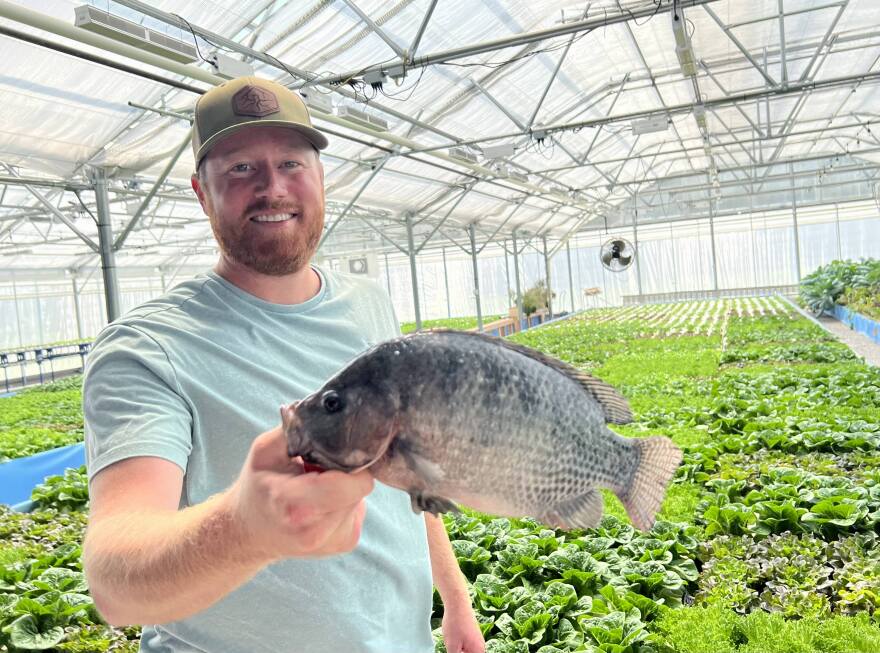Mike McGraw’s greenhouse in southwest Ohio looks different from the farms around it. He doesn’t rely on plots of soil. But, rather, bright blue tanks, filled with energetic fish that splash and dart at the sight of McGraw approaching.
“They're hungry, they're healthy, they're active,” McGraw said pointing at the fish. “That's what we want to see, all the time.”
This small army of tilapia is in charge of feeding a whole ecosystem at RootHouse Aquaponics in Batavia. McGraw raises the fish. They poop. And that waste is filtered and used to feed rows and rows of lettuce floating in a tank of water. Then McGraw sells both the fish and the plants to local markets. It’s called “aquaponics."
McGraw admits it’s a difficult process, and an expensive one. It took around half a million dollars for him to get started. And, he said, there wasn’t a lot of research to guide him.
“There is really no prescription for this type of farming. We're still figuring out how to make it better,” McGraw said.

That could be why there aren't many farms like this one operating in the state. Purdue University researchers are hoping to turn the tide. A grant from the United States Department of Agriculture aims to make it easier for Ohio – and other Midwest states – to produce seafood, far from the ocean.
Efficient farming
Ohio State University aquaculture extension specialist Nicole Wright is on the research team. She said investing in aquaponics is important because facilities like McGraw's are a bang for your buck, environmentally speaking. They use less land and less water for more food.
“We have a growing population in this country and around the planet. And we only have so much land and water,” Wright said. “And so in order to feed a growing population, you really need to be as efficient as possible in growing the resources that you need.”

Plus, there’s a high demand for seafood that we can’t rely on large bodies of water like Lake Erie to fulfill. Wright said there are strict limits on both commercial and recreational fishing on the lake.
“It's a limited resource that we have,” she said. “And so when we look at how do we increase seafood production, anywhere, it's going to be through aquaculture, through farming.”
So, Wright said, why not, then, take seafood production indoors and inland?
Upending barriers
There are plenty of barriers that prevent seafood production in the Midwest, said Bill Lynch, president of Ohio’s Aquaculture Association.
He said fish farmers in the state, like himself, mostly sell to stock ponds. It’s more profitable than trying to compete with foreign imports of seafood as a small operation. More than 70 percent of food-grade fish in the US comes from abroad.
“Those foreign imports can undercut us and with our input costs going up, it's tough to raise prices on food fish,” he said.
It’s just not economically viable in its current state, Lynch said. That’s what the team of researchers at Purdue University want to address by finding more revenue streams for aquaponics.

One potential solution: selling the fish poop as fertilizer. Wright said there’s no reason that fish waste has to go to waste when it can be used to increase economic gains for producers.
“It's a very safe fertilizer. It's very organic, very natural, and plants love it,” McGraw said. “So yeah, there's definitely a market for that.”
A roadmap
Wright’s team will also see if that fish waste could be processed into a biogas to help power the aquaponics system itself. That would lessen electrical costs – and hopefully make the industry more appealing to wannabe Ohio fish farmers.
“Maybe we can't do away with some of those upfront costs, but, if we can reduce some of the operation costs, that would be a benefit to folks,” Wright said.
The research will take five years, and feedback from a lot of fish farmers, until it’s ready.
But ultimately, Wright said she hopes it can be like an aquaculture roadmap. One that makes seafood production in Ohio sound less like a fish out of water.



